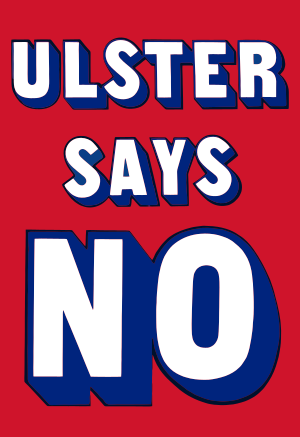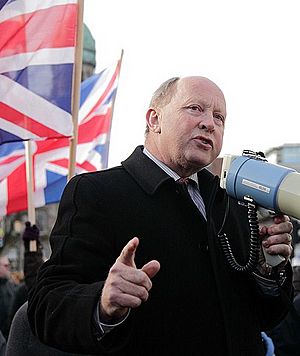Northern Ireland Assembly (1982) facts for kids
Quick facts for kids Northern Ireland Assembly |
|
|---|---|
| Devolved Assembly | |
| Type | |
| Type | |
| History | |
| Established | 20 October 1982 |
| Disbanded | 23 June 1986 |
| Preceded by | Northern Ireland Constitutional Convention |
| Succeeded by | Northern Ireland Forum |
| Leadership | |
|
Speaker
|
|
| Seats | 78 |
| Elections | |
| STV | |
| Meeting place | |
 |
|
| Parliament Buildings, Stormont, Belfast | |
The Northern Ireland Assembly was a special government body set up in 1982. Its main goal was to bring back devolution to Northern Ireland. Devolution means having a local government that makes decisions for its own region, instead of all decisions being made by the main government in London. This Assembly was an attempt to restore local rule after it had been stopped 10 years earlier. However, the Assembly did not succeed in its goal and was closed down in 1986.
Contents
Why the Assembly Was Created
The idea for the Assembly came from British government officials, especially the Secretaries of State for Northern Ireland, Humphrey Atkins and James Prior. They wanted to find a way for Northern Ireland to govern itself again.
Early Ideas for Local Government
In 1979, the government suggested a meeting to discuss Northern Ireland's future. Some political parties, like the Democratic Unionist Party (DUP), the Alliance Party, and the Social Democratic and Labour Party (SDLP), attended these talks. However, they couldn't agree on how a new government should work.
One big disagreement was about power sharing. This means that different political groups, even those who disagree strongly, would share power in the government. Some parties wanted this, but others preferred Majority Rule, where the party with the most votes would govern alone. Because of these disagreements, it was hard to find a solution that everyone liked.
A New Plan for Devolution
In 1982, a new plan was put forward by James Prior. It suggested a 78-member Assembly. Members would be chosen through a voting system called the Single Transferable Vote.
At first, the Assembly would only check on what government departments were doing. It would give advice and recommendations to the Secretary of State. The plan also said that powers could slowly be given to the Assembly. This would happen if 70 percent of the Assembly members agreed.
However, some important areas, like law and order, would always stay with the main British government. The British government made it clear that any local government in Northern Ireland needed support from both Unionists and Nationalists to work well.
Choosing the Assembly Members
The election for the Assembly happened in 1982. The voting system used was the Single Transferable Vote. This system helps make sure that smaller parties can also win seats.
Election Results and Key Parties
There was a lot of interest in how Sinn Féin would do, as it was their first big election in many years. People also watched the competition between the two main Unionist parties: the DUP and the Ulster Unionist Party (UUP).
The results showed that Sinn Féin gained 5 seats. They chose not to take their seats, a policy known as abstentionism. The SDLP, another Nationalist party, won 14 seats. However, one of their members, Seamus Mallon, lost his seat. This happened because he was also a member of the Irish Parliament, which made him ineligible.
On the Unionist side, the UUP won more seats than the DUP. The Alliance Party, which aimed to represent both communities, did well and got 10 seats.
The Assembly in Action (1982-1986)
After the election, the Assembly began its work. However, not all parties fully participated.
Who Participated and Why
The UUP, led by James Molyneaux, was at first hesitant to join the Assembly. They eventually agreed to work on the Assembly's committees. The DUP and the Alliance Party were keen to make the Assembly work and actively joined the committees.
The SDLP decided not to take their seats in the Assembly at all. They believed the plan wasn't a real solution to Northern Ireland's problems. They felt that Unionists were not willing to share power. Also, they wanted an "Irish dimension," meaning more involvement from the Irish government in Northern Ireland's affairs. The disqualification of Seamus Mallon further discouraged them.
Instead of the Assembly, the SDLP focused on the New Ireland Forum. This was a series of discussions held in Dublin by the Irish government. The Irish leader, Garret FitzGerald, supported the SDLP's decision not to join the Assembly. He believed it helped prevent more people from voting for Sinn Féin.
Debates and Disagreements
The Assembly often debated important issues. In May 1983, there was a big discussion about the future of the Assembly. The DUP wanted it to continue as a body that checked on government work. The UUP wanted to focus only on getting full local government back. The Alliance Party insisted that any local government must involve power-sharing between Unionists and Nationalists. None of these ideas gained enough support.
The Secretary of State, James Prior, kept reminding the Assembly that local government needed support from both Unionists and Nationalists. The DUP made it clear they would rather have no local government than share power with Nationalist parties.
The Assembly also debated controversial topics, like the flying of the Irish tricolour. Unionist members wanted stricter rules against displaying it. They saw it as a symbol of a different state.
Challenges and Protests
In November 1983, the UUP temporarily left the Assembly. This was after a shooting incident at a church, which they felt showed a lack of security. Some UUP members later returned, but the party tried to change the rules so that local government could be formed without Nationalist politicians. This attempt was not successful.
Later, in 1984, both the UUP and DUP published their own ideas for local government. Both rejected power-sharing with the SDLP. The UUP wanted the Assembly to make decisions but not pass laws. The DUP wanted a majority-rule government, but with some protections for minorities.
The British government continued to look for ways to make the Assembly work. The new Secretary of State, Douglas Hurd, warned that if the Assembly didn't succeed, the British government would look for new ways to govern Northern Ireland. He also mentioned continuing talks with the Irish government. This made Unionists worried.
The Anglo-Irish Agreement and the Assembly's End
Unionist concerns grew during 1985. The Royal Ulster Constabulary (RUC) sometimes stopped or limited traditional Unionist marches. This added to their anxiety.
In November 1985, the Anglo-Irish Agreement was signed. This agreement gave the Irish government a say in Northern Ireland's affairs for the first time. Unionists felt very angry and betrayed by this. Many protests and street demonstrations followed.

The Assembly held a special meeting after the Agreement was signed. Most members, except the Alliance Party, voted to ask for a public vote (referendum) on the Agreement in Northern Ireland. The DUP then proposed setting up a committee to look into the Agreement's impact. All normal Assembly meetings were stopped, except for one committee. The Alliance Party then left the Assembly completely. This meant only 49 of the 78 elected members were still attending.
From January to March 1986, the Assembly's work became even more difficult. Unionists stopped participating in committees. The Assembly became mainly a place for Unionists to protest against the Anglo-Irish Agreement.
Finally, on 23 June 1986, the Secretary of State ordered the Assembly to be closed down. Some Unionist members refused to leave the Assembly chamber. Police had to remove them by force in the early hours of the next morning. Protesters outside threw stones at the police.
What Happened Next
Because Nationalist parties did not participate, and Unionists later boycotted parts of it, the planned local government never fully happened. After the Anglo-Irish Agreement in 1985, Unionists used the Assembly to protest. This led to the Alliance Party leaving. As a result, the government closed the Assembly on 23 June 1986. It would be more than ten years before a new Assembly was set up in Northern Ireland.
Speaker of the Northern Ireland Assembly
- 1982–1986 James Kilfedder (Ulster Popular Unionist Party)
Images for kids



